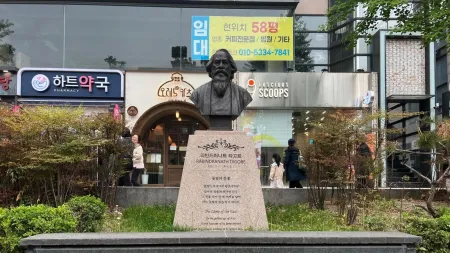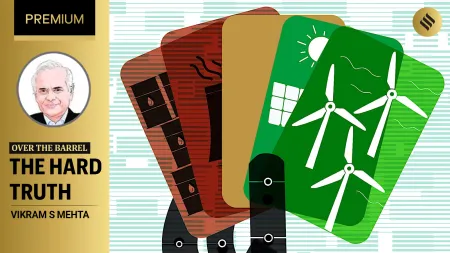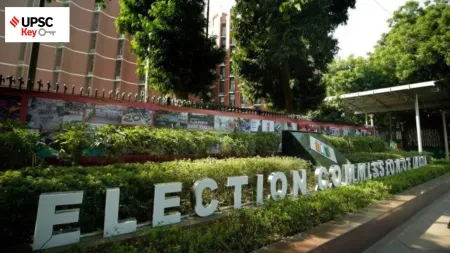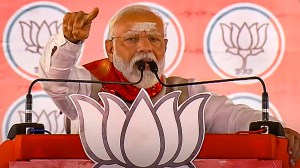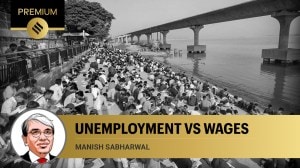- India
- International
UPSC Key | 23rd April, 2024 — Abortion law, semiconductor, plastic treaty and more
Exclusive for Subscribers from Monday to Friday: How are abortion laws and heat waves relevant to the UPSC Exam? What significance do topics like plastic treaty and semiconductors have for the preliminary and main exams? You can learn more by reading the Indian Express UPSC Key for April 23, 2024.
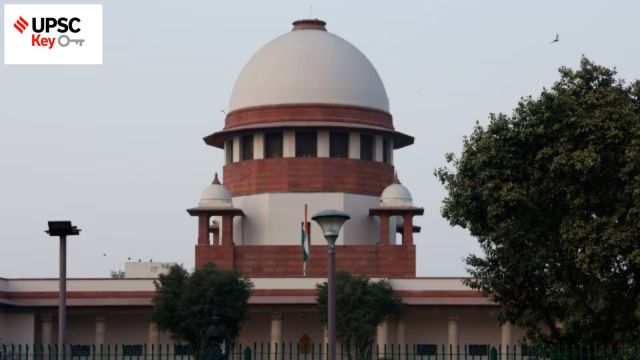 Under law, the Medical Termination of Pregnancy Act (MTP Act) allows the termination of pregnancy up to 20 weeks on the advice of one doctor. Know more in our UPSC Key.
Under law, the Medical Termination of Pregnancy Act (MTP Act) allows the termination of pregnancy up to 20 weeks on the advice of one doctor. Know more in our UPSC Key.Important topics and their relevance in UPSC CSE exam for April 23, 2024. If you missed the April 22, 2024 UPSC CSE exam key from the Indian Express, read it here.
🚨 The Indian Express UPSC Essentials brings to you the April edition of its monthly magazine. Click Here to read. Share your views and suggestions in the comment box or at manas.srivastava@indianexpress.com🚨
Front Page
SC: Denying women child care leave is violation of Constitution
Syllabus:
Preliminary Examination: Current events of national importance, Indian Polity- Constitution, Right Issues.
Mains Examination: GS II: Governance, Constitution, Polity, Social Justice.
What’s the ongoing story- Participation of women in the workforce is a constitutional entitlement and denying mothers child care leave violates this, the Supreme Court said Monday. A bench of Chief Justice of India D Y Chandrachud and J B Pardiwala was hearing a plea by a woman, who said the Himachal Pradesh government had denied her child care leave to attend to her child who is suffering from a genetic condition.
Prerequisites:

— What are the articles of the Indian Constitution related to gender equality and women?
(Thought Process: Read articles 14, 15, 16, 21, 39, 39(A), 42, 51 A (e), Reservation of Seats for Women in Panchayats and Municipalities)
— Know about the Right to Persons with Disabilities (RPWD) Act.
— What is the Medical Termination of Pregnancy Act, 1971?
Key takeaways:
— “Participation of women in the workforce is a matter not just of privilege but a constitutional entitlement protected by Article 15 of the Constitution. The state as a model employer cannot be oblivious to the special concerns which arise in the case of women who are part of the workforce,” the bench said in its order.
— “The provision of child care leave to women sub-serves an important constitutional objective of ensuring that women are not deprived of their due participation as members of the workforce. Otherwise, in the absence of provision for child care leave, a mother may be constrained to leave the workforce,” it said.
Also in News: SC allows 14-yr-old rape survivor to terminate 30-week preganancy
— The Supreme Court has allowed a 14-year-old victim of sexual assault to terminate her almost 30-week pregnancy.
— The Medical Termination of Pregnancy Act, 1971 (MTP Act) allows the termination of pregnancy under the following circumstances.
(i) Upto 20 weeks, termination is allowed on the advice of one doctor.
(ii) In case of a pregnancy of 20-24 weeks, abortion is allowed as an exception, but only under certain categories, after two registered medical practitioners have evaluated the right to seek termination.
(iii) After 24 weeks of pregnancy, the law requires that a medical board be set up in “approved facilities”, which may “allow or deny termination of pregnancy” only if there is substantial foetal abnormality.
— Section 3B of the Rules under the MTP Act lists seven categories of forced pregnancies, including statutory rape in case of minors or sexual assault; women with disabilities; or when there is a change in marital status of women during pregnancy.
— While courts have read the MTP Act liberally, the test of “foetal viability” as a benchmark to allow abortion is new in India. The landmark 1973 US Supreme Court verdict in ‘Roe v Wade’ that made abortion a constitutional right allows abortion up to the point of foetal viability, that is, the time after which a foetus can survive outside the womb.
Points to Ponder:
— What is India’s abortion law?
— What is the concept of a welfare state?
— ‘Bhatou Boro v. State of Assam’ (2017) The case is related to what?
— What do you understand by the test of “foetal viability”?
— What is the significance of the Justice K.S. Puttaswamy (Retd.) vs. the Union of India and Others (2017) judgment with reference to women’s reproductive rights?
Post Read Question:
Mains
Is there a question of ‘foetal viability’ in abortion in India, and do the rights of an unborn child matter in the same way as in many jurisdictions abroad?
“The Indian legal framework on reproductive rights tilts to the side of the woman’s autonomy to decide and choose more than towards the rights of the unborn child.” Comment.
Other Important Articles Covering the same topic:
What is ‘foetal viability’ in abortion, and do the rights of an unborn child matter?
Abortion laws around the world
Amid India’s chip push, Taiwan flags talent gaps, high import tariff
Syllabus:
Preliminary Examination: Current events of national and international importance
Mains Examination: GS-II, GS-III; Government policies and interventions for development in various sectors and issues arising out of their design and implementation; Effect of policies and politics of developed and developing countries on India’s interests, Indian diaspora, indigenization of technology, growth and development.
What’s the ongoing story- A “cumbersome” administrative structure, lack of experienced engineers, high tariffs on electronics component imports and inadequate infrastructure — these are some of the challenges that India needs to address before chip companies from the island territory start to commit serious investments, a top Taiwanese government representative said.
Prerequisites:
— What is a semiconductor?
— What is a Free Trade Agreement (FDA)?
— What is the supply chain?
Key takeaways:
— Joseph Wu, Taiwan’s Minister of Foreign Affairs, said- In order to get the major semiconductor production to move to India, we need to think about the whole supply chain coming together.
— India’s $10 billion chip incentive scheme has found some success in attracting a foundry investment from Tata and PSMC.
— The Indian government has created a dedicated task-force called the India Semiconductor Mission, which aims to serve as a focal point for an efficient implementation of New Delhi’s chip ambitions.
— Taiwanese chip companies have red-flagged India’s lack of adequate infrastructure needed to support the task of making semiconductors.
— Taiwanese chip companies have red-flagged India’s lack of adequate infrastructure needed to support the task of making semiconductors.
For Your Information:
— In December 2021, the government had rolled out a Rs 76,000 crore chip incentive scheme, under which the Centre offered half the amount of a plant’s capital expenditure costs as subsidy.
—India’s chip incentive plans are focused on boosting all three aspects of the semiconductor ecosystem – packaging units called ATMP facilities; assembly and testing projects called OSAT plants; and full-scale foundries that can manufacture chips.
— Semiconductors are highly complex products to design and manufacture, that provide the essential functionality for electronic devices to process, store and transmit data.
Points to Ponder:
— What are the materials used in the semiconductor industry?
— What is the India Semiconductor Mission (ISM)?
— India’s agreement with other countries (USA, Taiwan, EU) on cooperation on the semiconductor ecosystem.
(Thought process: Highlight the significance of indiginisation of the semiconductor ecosystem–connect it with economy-import bills-India’s mission to atmanirbhar Bharat–look at the semiconductor materials imported from other countries–look at government schemes and various agreements signed by the government).
Post Read Question:
— Discuss the significance of the semiconductor industry to the Indian economy. Highlight the government initiatives to strengthen India’s semiconductor ecosystem.
Other Important Articles Covering the same topic:
India, EU sign semiconductor pact
US to reboot India’s chip ambitions, will help plug-in to global alliances
The Editorial Page
The cost of health
Syllabus:
Preliminary Examination: Economic and Social Development – Sustainable Development, Poverty, Inclusion, Demographics, Social Sector Initiatives, etc.
Mains Examination: GS-II, Issues relating to development and management of Social Sector/Services relating to Health, Education, Human Resources; Government policies.
What’s the ongoing story- Sanjay Nagral writes- “The Supreme Court recently spoke strongly on this issue it resonated with many. The Bench was hearing a PIL by an NGO praying for direction to determine charges in hospitals across the country in terms of Rule 9 of the Clinical Establishment Act. The Court threatened to impose the Central Government Health Scheme (CGHS) rates on all hospitals as an interim measure. It gave the state six weeks to act. Is it possible for the top court to intervene effectively where governments have failed? What exactly is it wading into?”
Prerequisites:
— What is the out-of-pocket expenditure?
— What is Universal Health Care (UHC)?
— Difference in the private healthcare and public healthcare
Key takeaways:
— “If there is one policy which should be prioritised by a nation that genuinely cares for its citizens, it is a publicly funded health system which gives timely, effective and free care, irrespective of social class.”
— “After independence, the underfunding of public facilities made space for an alternative (private sector healthcare) to emerge.”
— “Characteristics crucial to understanding private healthcare in India: Healthcare does not follow market rules. It involves unpredictability, distress and relies on empathy. That’s why even dominant market economies insulate healthcare.”
— “Secondly, healthcare in India is one of the least regulated. Finally, it is characterised by a deep co-option of medical professionals.”
— “ The growing private health insurance sector also demanded regulation. The Clinical Establishment Act was introduced in 2010 partly as a response to these needs. Many state governments have not yet implemented it or done so half-heartedly.”
— “The Supreme Court’s intervention is potentially powerful but it is entering tricky territory. Any effective intervention will face resistance not only from industry, but also influential doctors, many of whom are entrepreneurs.”
— “ If the Court wishes to promote affordable healthcare, capping costs could be a small step. But no nation has improved substantively in health equity without adequate state investment.”
For Your Information: From Explained
— The Insurance Regulatory and Development Authority of India (IRDAI) has removed the ceiling of age 65 for individuals buying health insurance.
— “India is a predominantly young country currently, but the share of the population above the age of 60 is projected to reach 20% by 2050.”
Do you know?
— What is geriatric care?
— What is the ‘Kerala model’ of the care economy?
Points to Ponder:
— What is the state’s share in the health sector?
— Role of NGOs in the healthcare sector
— What are the challenges in implementing universal health coverage?
(Thought Process: Highlight the plight of public health care system in India- cite data from NFHS 5, Economic survey- India’s expenditure on health sector- problems faced by poor section of the society-Highlight schemes of the government (Ayushman Bharat Health Insurance)-path to attain the SDG goals(3.8) and Vikshit Bharat).
Post Read Question:
— Public health system has limitations in providing universal health coverage. Do you think that the private sector could help in bridging the gap? What other viable alternatives would you suggest? (2015)
Other Important Articles Covering the same topic:
BJP promises to extend Ayushman Bharat to all senior citizens: What is the significance?
‘Enact Right to Healthcare legislation to ensure quality healthcare to all’: Dr Abhay Shukla
Kerala wants to ‘develop an army of caregivers’
Paying their fair share
Syllabus:
Preliminary Examination: Current events of national and international importance, economy.
Mains Examination: GS-II, GS-III, Economic Development, Bilateral, regional and global groupings and agreements involving India and/or affecting India’s interests.
What’s the ongoing story- Suranjali Tandon writes- “Tax treaties are integral to cross-border investment relations as they define the treatment of incomes that arise in one country accruing to a resident of another country. Their design is also a reflection of the underlying power equation. Developing countries often negotiate treaties that cede greater taxing rights in the hope of higher investments. Whether it is legitimate for third countries to avail of such benefits by routing investments through the preferential jurisdiction has been discussed widely.” In this context, recent India-Mauritius treaty amendments have become important.
Prerequisites:
— What do you understand by the Base Erosion and Profit Shifting program?
— What is the Organisation for Economic Co-operation and Development (OECD)?
— What do you understand by the term “treasury shopping”?
Key takeaways:
— “The Base Erosion and Profit Shifting programme was to end the use of low-tax jurisdictions for tax avoidance. Since then the OECD — that was tasked with the redesign of international tax laws to push forward such reform — has developed a set of best practices under 15 action points. One among these was the multilateral instrument (MLI) that allowed countries the option to select tax treaties and provisions therein that would be amended suitably and swiftly. The instrument received wide support.”
— “One of the key reforms it initiated was the inclusion of a provision for prevention treaty abuse as a minimum standard and an amendment of the preamble to the treaties. The latter is to prevent non-taxation or reduced taxation through tax evasion, including treaty-shopping arrangements that provide benefits to residents of other jurisdictions and anti-abuse rules that will enable tax administrations to deny treaty benefits in certain circumstances.”
— “India is among the signatories to the MLI and in line with its position, the recent amendment to the India-Mauritius treaty signals the keenness to plug the well-known loophole.”
— “ It is expected that the amendments to the treaty allow the authorities to move beyond the residency certificate and assess the principal purpose of an arrangement or transaction.
— “16 per cent of FDI inflows in 2021-22 were from Mauritius, the reform will impact the composition of flows, as was observed after the amendments in 2017 when capital gains became taxable at source in India.”
For Your Information:
— India and Mauritius, on March 7, signed a protocol at Port Louis, amending the Double Taxation Avoidance Agreement (DTAA) between the two nations.
— The amended pact includes the Principal Purpose Test (PPT), which is in line with the global efforts against treaty abuse, particularly under the BEPS (Base Erosion and Profit Shifting) framework. The PPT essentially implies that the tax benefits under the treaty will not be applicable if it is established that obtaining that duty benefit was the principal purpose of any transaction or arrangement.
Points to Ponder:
— What is the OECD’s multilateral instrument (MLI)?
— What is the Double Taxation Avoidance Agreement (DTAA)?
— What do you understand by the Principal Purpose Test (PPT)?
— What are the General Anti Avoidance Rules (GAAR)? When was it introduced?
— What is the subject of tax rule?
Post Read Question:
Mains
“International tax law is turning a new page as the treaties with serious revenue implications are now being reformed.” Explain.
Other Important Articles Covering the same topic:
Why text of amended tax treaty with Mauritius triggered stock sell-offs
India, Mauritius revise tax treaty, aim to plug evasion
Explained
Plastic treaty talks: What do countries, firms want?
Syllabus:
Preliminary Examination: Current events of national and international importance, General issues on Environment.
Mains Examination: GS-II, GS-III, Environment, environmental pollution and degradation, Bilateral, regional and global groupings and agreements involving India and/or affecting India’s interests,
What’s the ongoing story- Global leaders will gather in Canada’s capital this week to discuss progress in drafting a first-ever global treaty to rein in soaring plastic pollution by the end of the year. The hoped-for treaty, due to be agreed at the end of this year, could be the most significant deal relating to climate-warming emissions and environmental protection since the 2015 Paris Agreement.
Prerequisites:
— What is the Paris Agreement?
— What are the different types of plastic waste?
— Read about plastic pollution and its impact.
— Important Terms to Know: Virgin Plastic, Single-Use Plastic, Extended producer responsibility.
Key takeaways:
— At the U.N. Environmental Assembly in 2022, the world’s nations agreed to develop a legally binding agreement by the end of 2024 to address the world’s plastic pollution crisis.
— The treaty is meant to address plastics through their entire lifecycle – from when they are produced, to how they are used and then disposed of.
— Many plastic and petrochemical-producing countries including Saudi Arabia, Iran and China – known collectively as the group of Like-Minded Countries – have opposed mentioning production limits.
— The “High-Ambition Coalition”, which includes EU countries, island nations and Japan, wants to end plastic pollution by 2040.
— These Petrochemical companies want to focus on encouraging the reuse or recycling of plastics, including deploying technology that can turn plastic into fuel, though a previous Reuters investigation found enormous obstacles in this method.
Points to Ponder:
—What are the challenges associated with plastic waste management?
— What are the measures taken by the Indian government to curb plastic pollution?
(Thought process: Read about the Plastic Waste Management Rules, India Plastics Pact, National Dashboard on Elimination of Single-Use Plastic and Plastic Waste Management, Project REPLAN and other initiatives taken by the government)
— What is the High-Ambition Coalition?
Post Read Question:
In India, ‘extend producer responsibility’ was introduced as an important feature in which of the following? (2019)
(a) The Bio-medical Waste (Management and Handling) Rules, 1998
(b) The Recycled Plastic (Manufacturing and Usage) Rules, 1999
(c) The e-Waste (Management and Handling) Rules, 2011
(d) The Food Safety and Standard Regulations, 2011
Other Important Articles Covering the same topic:
Why most plastic can’t be recycled
COP, carbon market, loss and damage: A glossary of climate terms
Why High Court upheld Karnataka’s ban on hookah
Syllabus:
Preliminary Examination: Indian Polity and Governance
Mains Examination: GS-II, Issues relating to development and management of Social Sector/Services relating to Health, Education, Human Resources; Government policies
What’s the ongoing story- The Karnataka High Court on Monday (April 22) upheld the state government’s ban on hookahs as being in the interest of the general public, and ruled that hookah bars were an illegal “service” under India’s anti-tobacco law.
Prerequisites:
— What are the Directive Principles of state policy (DPSP)?
— What are the Fundamental Rights enshrined in the Indian constitution?
Key takeaways:
— The government argued that Article 47 (DPSP) of the Constitution places a duty on the State to “raise the level of nutrition and the standard of living and to improve public health”, which includes the “prohibition of the consumption except for medicinal purposes of intoxicating drinks and of drugs which are injurious to health”.
— According to the Constitution, directive principles are not “enforceable by any court, but the principles therein laid down are nevertheless fundamental in the governance of the country and it shall be the duty of the State to apply these principles in making laws”.
— The HC held that Article 47 was intrinsically linked with the right to life with dignity under Article 21.
— “The paramount duty is cast upon the States and its authorities to achieve appropriate level of protection to human life and health which is a fundamental right guaranteed to the citizens under Article 21,” it said.
— The petitioners argued that the government’s notification violates the fundamental right to “practise any profession, or to carry on any occupation, trade or business” guaranteed by Article 19(1)(g).
— However, the court held that this freedom can be subject to certain reasonable restrictions including the prohibition of certain occupations, trades and businesses, if it is “in the general interest of the public”.
— The court also held that a directive principle such as Article 47 can be used to justify a restriction on citizens’ rights under Article 19(1)(g).
Do you know:
— What is constitutional morality?
— What is the basic structure doctrine?
Points to Ponder:
— How has the alcohol ban been justified by the states?
— What is the precedence of DPSP over Fundamental Rights?
— What is the best approach for a state- ban or regulation?
(Thought process: DPSP (Part IV of the constitution) focuses on the welfare state and Fundamental Rights (Part III of the constitution) focuses on liberal political democracy—cite landmark cases like State of Kerala vs NM Thomas and I.R. Coelho vs State of Tamil Nadu – empahsise on the harmonious and complementary relationship between DPSP and FR)
Post Read Question:
“DPSPs are fundamental in the governance of the country and it shall be the duty of the state to apply these principles in making laws.” Examine
Other Important Articles Covering the same topic:
Our hypocrisy on alcohol: It’s about politics and money — not health
Shouldn’t reject constitutional morality, says CJI Chandrachud
The Ideas Page
Climate’s new normal
Syllabus:
Preliminary Examination: General issues on Environmental Ecology, Biodiversity and Climate Change – that do not require subject specialisation.
Mains Examination: GS-III, Conservation, environmental pollution and degradation, environmental impact assessment.
What’s the ongoing story- Bijal Vachharajani writes- “Warmest January on record already. Warmest 2023 since “global records began in 1880” (NASA). 2024 seems to be all set to beat this unenviable record. Delayed snow in the Jammu, Kashmir and Ladakh regions. India emerged as a top contender for climate hotspot in a study conducted by researchers from the Indian Institute of Technology and the University of Augsburg, Germany. Yet again, we are witnessing a tsunami of heat waves that the IMD has warned about.”
Prerequisites:
— What are heat waves?
— What are extreme weather conditions?
— What is the Shifting Baseline Syndrome?
Key takeaways:
— “The Supreme Court of India recognised in March — a distinct right “to be free from the adverse effects of climate change.”
— “In 2023, UNICEF estimated that “76 per cent of children in South Asia are exposed to extreme high temperatures where 83 or more days in a year exceed 35°C.” That’s 460 million children under the age of 18. And that, “3 in 4 children in South Asia are already exposed to extreme high temperatures compared to only 1 in 3 children (32 per cent) globally.”
— “Additionally, each unprecedented weather event is embedded with trauma and stress. Our children are one of the most vulnerable to the climate crisis.”
— “But each generation’s understanding and acceptance of their environmental conditions are constantly being lowered — a phenomenon called Shifting Baseline Syndrome.”
For Your Information:
—- Recently in News, an example of extreme weather conditions: UAE recorded the heaviest rain ever after a severe thunderstorm hit the country on April 15. Heavy rains are unusual in the UAE, which is an arid, Arabian Peninsula country.
— According to a Call for Action released by United Nations (UN) agencies, “pregnant women, babies and children face extreme health risks from climate catastrophes that warrant urgent attention.”
— According to the UNICEF Deputy Executive Director for Programmes, Omar Abdi, “the climate crisis is jeopardising every child’s fundamental right to health and well-being. It is our collective responsibility to listen and put children at the centre of urgent climate action, beginning at COP28. This is the moment to finally put children on the climate change agenda.”
Points to Ponder:
— What actions need to be taken to address the impact of climate change, especially on women and children?
— COP 28 outcome to tackle child rights crisis
— How does climate change impact intergenerational equality?
(Thought process: Think from the perspective of impact of climate crisis on the vulnerable section of the society–focus on women and children–highlighting the report of UN and COP 28 outcome–look at the impact from environmental displacement to mental health–point to the change causing intergenerational inequality-ponder on the steps that the international community need to take.)
Post Read Question:
Mains
“Action on climate change often ignores that children’s bodies and minds are uniquely vulnerable to pollution, deadly diseases and extreme weather.” Analyse.
Other Important Articles Covering the same topic:
New studies reveal impact of climate change on kids, pregnant women in Indian cities
Climate change an urgent threat to children, pregnant women: UN report
Economy
Over 70 Per cent workers globally exposed to excessive heat, India’s manual labour at risk’
Syllabus:
Preliminary Examination: Current events of national and international importance
Mains Examination: GS-I,GS-II, GS-III, Important Geophysical Phenomena, Climate Change Environmental Pollution & Degradation, Government Policies & Interventions,
What’s the ongoing story- Over 70 per cent of all workers globally are exposed to excessive heat due to rising temperatures and a growing labour force, marking an increase of 34.7 per cent in exposure estimates in the 20-year period between 2020 and 2000, as per a report titled ‘Ensuring safety and health at work in a changing climate’ by the International Labour Organization (ILO).
Prerequisites:
— What are heat waves?
— Know about the International Labour Organization (ILO)
— What are the parasitic and vector-borne diseases?
Key takeaways:
— In hot and rural regions of countries like India, epidemics of chronic kidney disease of unknown aetiology (CKDu) are affecting large numbers of workers conducting heavy manual labour, the UN-agency said in its report citing data from a study.
— Every year, an estimated 22.85 million occupational injuries, 18,970 deaths and 2.09 million disability-adjusted life years (DALYs) are attributable to excessive heat alone, the ILO report said. Out of a total global workforce of 3.4 billion workers, at least 2.41 billion workers are exposed to excessive heat every year, report added.
— In 2020, there were an estimated 26.2 million persons living with chronic kidney disease due to exposure to excessive heat at work.
— Climate change can have a negative impact on employment, including job losses, damage to business assets and business interruptions, decreased labour productivity and forced migration. The ILO said climate change threatens ecosystems and the 1.2 billion jobs that depend on them, such as farming, forestry and fishing.
— Those most at risk from excessive heat include outdoor workers in physically demanding jobs and indoor workers in poorly ventilated workplaces where the temperature is not regulated.
— Women workers may be at increased risk due to their job roles, such as in subsistence agriculture, while men workers are most likely to carry out heavy manual labour, for example in construction and agriculture, often in hot conditions, and are therefore at high risk of many climate change impacts.
Points to Ponder:
— What is the criteria for declaring Heat Wave in India?
— What is Chronic Kidney Disease of Unknown Etiology (CKDu)?
— What do you understand by the disability-adjusted life years (DALYs)?
— What do you understand by the term “urban heat island effect”?
Post Read Question:
Prelims
What are the possible limitations of India in mitigating global warming at present and in the immediate future? (2010)
1. Appropriate alternate technologies are not sufficiently available.
2. India cannot invest huge funds in research and development.
3. Many developed countries have already set up their polluting industries in India.
Which of the statements given above is/are correct?
(a) 1 and 2 only
(b) 2 only
(c) 1 and 3 only
(d) 1, 2 and 3
Mains
Bring out the causes for the formation of heat islands in the urban habitat of the world. (2013)
Other Important Articles Covering the same topic:
Explained: How global warming could impact jobs in India
UN warns India of loss of productivity due to global warming
Subscribe to our UPSC newsletter and stay updated with the news cues from the past week.
May 08: Latest News
- 01
- 02
- 03
- 04
- 05




